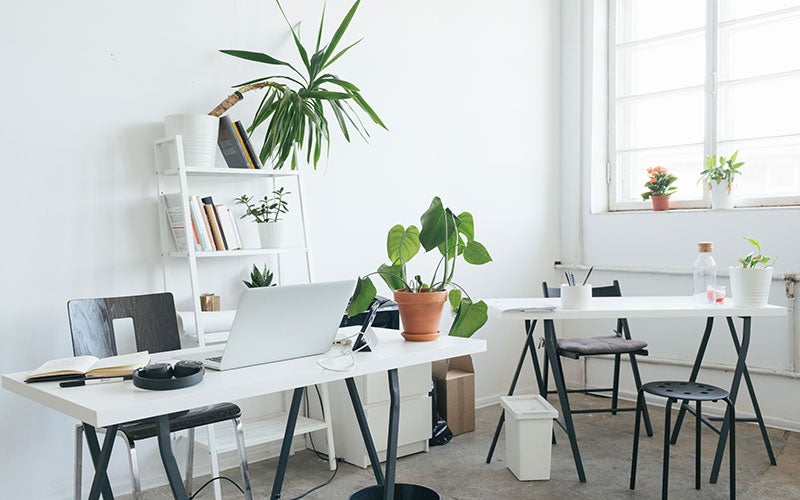How to set up a home office in 7 steps
 ©Westend61
©Westend61
Working from home can be both productive and pleasant, if you pay enough attention to your setup. Find out how to set up a home office with our seven tips and create a work-life paradise!
Keep Your Home Comfortable
Working from home or remotely has been the norm for certain jobs in startups and other agile companies for a while now. Employers and employees who once refused to allow working from home, thinking all it meant was afternoons of procrastination or sparkling clean apartments, were proven wrong in 2020.
It’s pretty normal to work from home now and it’s probably going to stay with us for a while. And even if we go back to working five days in the office, a well-furnished workplace at home still has its benefits. Use it to find some peace and quiet or just to take some time to work on your own projects!
7 Tips: How to set up a home office
Traditionally, home is actually supposed to be a place of relaxation, a private space where you can leave outside stress at the door. That’s why working and living at home can make it challenging to maintain a work-life balance: keeping productivity up while still being able to relax at the end of the day.
Meet the challenge head on with our 7 best home office setup tips.
#1 Define your needs
Before you replace your couch with a desk, ask yourself what you really need and how you can best use the space you have. How often do you work from home? Are you setting up your home office temporarily, or do you want it to be a permanent part of your furniture? Based on these parameters, you can define a budget, and decide on which priorities you want to set for your home office design.
#2 Find the perfect corner for your workspace
Ideally you would have your own room as a study. In a smaller apartment, however, it’s more likely that a quiet corner in the living room with good natural light is the only place available. A hallway might also be an option, depending on your layout.
Think about the environment you prefer to work in. Does it need to be quiet, or do you like to sit in the middle of the hustle and bustle to keep up your energy levels? What is your workflow like? Do you need quiet for top productivity or is convenience more important?
One thing everyone should keep in mind: if you can, try to reserve the bedroom for sleeping. If you have to work in your bedroom, organize your office so that you can neatly store or put away as much of your work as possible after hours. Thinking about work right before you go to sleep can send your thoughts into a spiral, making restful sleep basically impossible.
#3 Consider the available lighting
The basic principle for proper lighting is: The fewer harsh contrasts there are, the less eye strain.
Natural light falling on your workspace from the side is perfect. Sitting in a dark corner or looking straight at a window will make your eyes work too much and tire you out faster. But if you sit with your back to the window, the window and the outside light will be reflected on your screen.
Make sure that your study is also well lit beyond your computer. Floor lamps to the side of your desk provide indirect lighting, which is easier on the eyes. An adjustable desk lamp is also a good idea, especially when you occasionally need to read something on paper.
#4 Separate working from living
It’s still possible within one space! When setting up your home office, think about how you can create a visual boundary between living and working areas because office chairs rarely look particularly cozy.
While classic room dividers or open shelves clearly separate areas within a room, flowers are also a good solution for small rooms. A few large plants in front of or next to your desk won’t interfere with your office and ensure that your workspace blends organically into your living space. Plants also make for good air and a cozy atmosphere – the perfect solution for combining work and living.

There are no limits to your imagination: A colorful wall or collages in front of your desk serve as decorative elements that make your workspace look like a small study of its own.
# 5 Multifunctional home office space when it’s limited
This all sounds well and good, but where do you find the space? If you don’t have much space, think multifunctional when setting up your work area. Your desk can be a dining table in the evening and, with a nice blanket over it, an office chair can become a cozy armchair. Use the wall to organize your to-dos on the one hand and as a space for decoration on the other.
Find a locked storage space for your laptop, screen, keyboard, and your other (large) work materials on Friday nights. Replace them with flowers, pictures, or whatever your favorite decoration is. This way, your home office area becomes living space until Monday morning comes around again.
Make organizing your living room workspace a ritual: Set it up every morning and take it down every evening. This ritual helps your mind get ready for work and de-stress afterwards. It’s like commuting to the office. Only it all takes place within your own four walls.
# 6 Invest in aesthetics
A good working atmosphere increases productivity. And a good living atmosphere helps you to relax. However, a monitor, standing desk, and an office chair rarely seem all that decorative.
But office supplies at least can be: Hole punchers, paper trays, cable collectors, and magnetic planning boards now come in all colors, shapes, and materials. Choose ones that blend in well with the color scheme of your home and look more like decoration than the office. Think about a unified concept for the combination of colors and office materials that fits your entire room.
Maybe home office decorating is the perfect opportunity to change the look of your living room, repaint a wall, or implement a new interior design idea. Get creative and try to see remodeling as an opportunity instead of a necessary evil!
# 7 Keep things tidy
As your grandma always said: keeping things cleaned up is half the battle. At least when it comes to home office decor, she was right. A cluttered desk will always remind you of work. Are you the “creative chaos” type? Go for it! During the day.
But getting your space back in order in the evening will help you feel like you’re not still in the office in your own home, and help you shift into after-work mode and avoid many a working-from-home crisis. Even if it’s just throwing everything into a box and closing the lid.
Buy nice storage and decorative boxes so your office supplies will look nice even if you just throw them in wildly. It’ll save space and solve the tidiness issue at the same time!
A simple trick to keep things tidy, and up productivity, especially if you have lots of paperwork: Throw away any completed to-dos every evening and organize the new ones for the next day, either next to your computer or, for example, color-coded on some wall space that you won’t have to look at all evening.
Office furniture and materials
Now that we’ve gone through the compatibility of work environment and living spaces, let’s take a look at what furniture and office materials you should actually invest in when setting up your home office. Of course, it varies from case to case and depends on your kind of work.

Do you need an extra desk with a computer or are your remote hours at home flexible enough that you can work for a couple of hours just fine at the kitchen table?
A proper chair, or maybe even a standing desk, are certainly more comfortable and healthier, but if you’re only occasionally working from home, seat cushions and footrests may do the trick.
How much do I need to buy?
Follow the mantra: “As little as possible, as much as necessary”. What tasks do you have to do and what do you need for them? If you need to print twice a month, it might be worthwhile to go to a copy shop, a friend’s, or a co-working space instead of putting a printer in your living room.
If you’re at the computer all day, it’s almost always worth investing in a larger external monitor, and possibly a mouse and keyboard, for both comfort and productivity.
Is the internet connection strong enough at your new workspace? If not, consider a wi-fi booster. Bluetooth headphones make cell phone calls easier and allow you to sneakily hang laundry on the side when you’re just listening in on video calls anyway.
Set up Your Home Office: Ergonomics Tips
In the office, height-adjustable furniture and technology are standard. At your home desk, that might not be the case, but that’s no excuse to neglect ergonomics and your health! The more of our guidelines you can follow when setting up your home office, the better.
The best way to achieve ergonomic standards in the home office is with a mouse, keyboard, monitor and a stand for a laptop. The classic height for desks is between 60 and 85 cm. Ideally, your desk, chair, and monitor should all be height-adjustable or, at the very least, one of them should be. If you can’t adjust everything, other small things like footrests, seat cushions, and shoe boxes might be necessary.
Tip: Change your sitting position every now and then, stand up once every hour, and do quick sets of flexibility exercises to boost your fitness during the workday.
#1 Foot and Leg Position
Adjust your feet and legs correctly before moving on to the other settings.
Both feet should be relaxed and firmly planted on the floor, while your thighs are parallel to the floor and your knee is at a right angle. The best way to set this up is with a height-adjustable desk chair. If you can’t set your chair or desk low enough, elevate your feet with a footrest.
#2 Lumbar spine and back rest
With this leg position, sit upright and relaxed. Your hips and shoulders are roughly in the same vertical line, your gaze is straight ahead, and your neck is relaxed. If your backrest is adjustable, set its height so that its curve matches the natural curve of your lumbar spine to reduce back pain.
#3 Arm and hand position
With this leg and back position, let your arms hang relaxed. Then place your forearms in a relaxed position up toward your keyboard. Ideally, they’ll be able to rest relaxed on arm rests on each side of your chair. Your elbows should form a right angle and your forearms should be level with the desk. If you can’t set your desk low enough to keep your feet on the floor and your arms level, invest in a good seat cushion.
#4 Head and screen position
As a guideline, there should be 50 to 70 cm between your eyes and the monitor, which usually works best with a desk that is about 80 cm deep. If you are sitting according to the previous settings, your gaze should fall straight ahead on the upper edge of the screen.
If this is not the case, place your monitor higher – use hefty books or a stable shoe box if needed. This position relieves your neck while reading because your gaze automatically falls slightly downwards. Ideally, you can also slightly tilt the bottom edge of your screen toward you.
Conclusion
- When decorating your home office, choose colors and materials that suit you and the space you want to work in.
- Try to either strictly separate your spaces for working and living, or set up your home office so that it cohabitates with your living space as organically as possible while still being visually separate.
- The tidier you keep your office space, the easier it is to keep your work and private life separate when they’re in the same space.
- Positioning your desk and lighting the room are just as important as fancy ergonomic furniture.
- Multifunctional furniture and decorative storage help you make the most of limited space.
Sources for this article
We at foodspring use only high-quality sources, including peer-reviewed studies, to support the facts within our articles. Read our editorial policy to learn more about how we fact-check and keep our content accurate, reliable, and trustworthy.





























